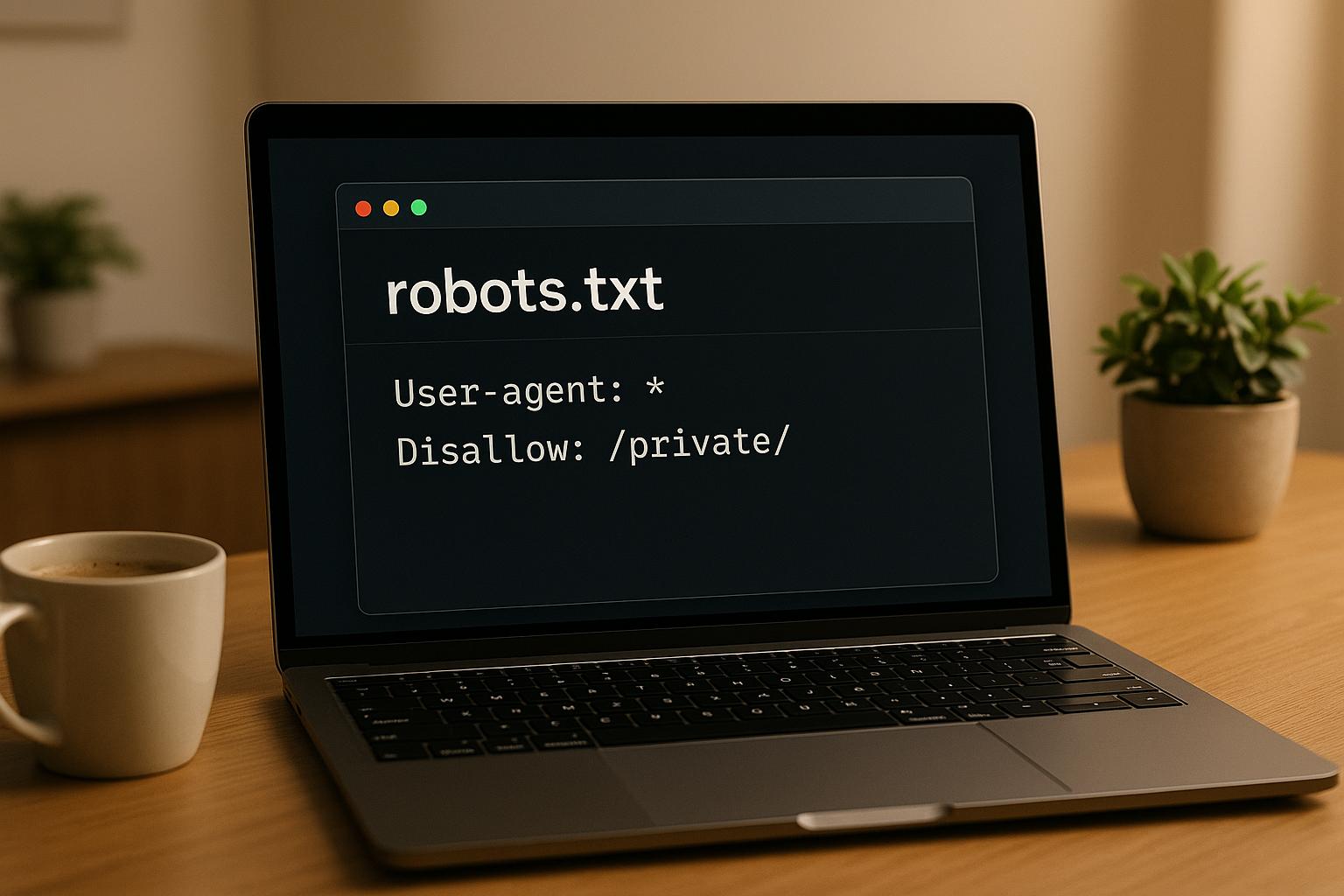The robots.txt file is a small but critical tool for managing how search engines interact with your website. It tells crawlers what they can and cannot access, helping to avoid server overload and improve SEO performance. A properly configured robots.txt file can:
- Optimize crawl efficiency by guiding bots to key pages.
- Prevent duplicate content issues by blocking unnecessary URLs.
- Protect private or outdated sections of your site.
- Include your XML sitemap for better indexing.
However, even minor mistakes in robots.txt can harm your SEO. Misconfigurations may block vital pages or disrupt internal linking. Advanced directives like wildcards (*), end-of-line operators ($), and Crawl-delay offer more control but require precision and careful testing.
Key points to know:
- Google no longer supports the
Noindexdirective in robots.txt (use HTML meta tags instead). Crawl-delayis ignored by Google but works with Bing, Yahoo, and Yandex.- Test your robots.txt file regularly using tools like Google Search Console‘s tester.
For small websites, standard directives like Disallow and Allow are often sufficient. Larger, more complex sites may benefit from advanced patterns to manage URL parameters, duplicate content, and server load. Always monitor changes to ensure your file works as intended.
robots.txt Explained Like Never Before ⚙️ Technical SEO Course + Live Examples & Best Practices
Basic Robots.txt Syntax and Structure
Understanding the structure of a robots.txt file is key to creating effective directives. It follows a strict format that web crawlers rely on to interpret instructions.
Main Directives: User-Agent, Disallow, and Allow
The robots.txt file uses three main directives – User-agent, Disallow, and Allow – to manage crawler access. These directives work together to form rule groups, where each group begins with a User-agent line followed by specific instructions.
- User-agent: Specifies which web crawler the rules apply to. You can target a specific crawler like Googlebot or use an asterisk (
*) to apply the rules to all crawlers. User-agent names are not case-sensitive, meaning "Googlebot" and "googlebot" are treated the same. - Disallow: Blocks crawlers from accessing specified URLs or directories. This directive is case-sensitive, so
/Resources/and/resources/would be treated as separate paths. - Allow: Creates exceptions to Disallow rules, letting crawlers access specific files or directories within restricted areas. This is especially helpful when you want to block a directory but still allow access to certain pages within it.
Here’s an example:
User-agent: Googlebot Disallow: /nogooglebot/ User-agent: * Allow: / Sitemap: https://www.example.com/sitemap.xml In this setup:
- Googlebot is blocked from accessing any URL that starts with
/nogooglebot/. - All other crawlers are allowed to access the entire site.
- The file also specifies the location of the sitemap for easier discovery by crawlers.
You can also create exceptions within blocked directories:
Disallow: /resources/ Allow: /resources/important-page/ This configuration blocks crawlers from the /resources/ directory but allows access to /resources/important-page/.
Next, let’s look at syntax rules and best practices to ensure everything functions as intended.
Syntax Rules and Best Practices
Correct syntax is critical for a robots.txt file to work properly. Barry Adams emphasizes the importance of precision:
"Disallow rules in a site’s robots.txt file are incredibly powerful, so should be handled with care. For some sites, preventing search engines from crawling specific URL patterns is crucial to enable the right pages to be crawled and indexed – but improper use of disallow rules can severely damage a site’s SEO."
Here’s what you need to know:
- File Name and Location: The file must be named
robots.txtand placed in the root directory of your website. It should be a plain text file encoded in UTF-8. - Host-Specific Rules: Rules only apply to the specific host, protocol, and port where the file is located.
- Trailing Slashes: Be mindful of trailing slashes. For example,
Disallow: /directory(without a trailing slash) blocks/directory/as well as files like/directory-one.html. Use precise paths to avoid unintended blocks. - Comments: Use the
#symbol to add comments. Crawlers ignore these, but they can help document rules for future reference. - Relative Paths: Always use relative paths like
/folder/instead of absolute URLs to avoid confusion.
Even though minor errors might be overlooked by some crawlers, it’s always a good idea to test your robots.txt file. Tools like Google Search Console’s robots.txt tester can help ensure your file is error-free before you deploy it.
Advanced Robots.txt Directives and How to Use Them
Once you’re comfortable with the basics, advanced robots.txt directives offer a finer level of control over how crawlers interact with your site. These tools are especially useful for managing complex crawling scenarios and ensuring your website runs smoothly.
Using Wildcards and End-of-Line Operators
Wildcards and end-of-line operators bring flexibility to your robots.txt file, allowing for precise pattern matching. The asterisk (*) wildcard matches any sequence of characters in a URL path. This is particularly handy for blocking dynamic URLs or entire content categories. For instance:
Disallow: /*?session= This directive blocks any URL containing "?session=" in its query parameters, preventing crawlers from indexing session-based URLs.
The dollar sign ($) acts as an end-of-line operator, ensuring that rules apply only to URLs ending with a specific string. For example, to stop Googlebot from crawling URLs ending in ".php":
Disallow: /*.php$ Without the dollar sign, the rule could unintentionally match URLs like /admin.php.backup.
| Pattern | What It Matches | Description |
|---|---|---|
/* |
All paths | Equivalent to /. The trailing wildcard is ignored. |
/*.php$ |
Paths ending with .php |
Matches paths that end precisely with ".php". |
/*.php |
Any path containing .php |
Risks blocking paths like /admin.php.backup. |
These pattern-matching techniques help you manage crawler behavior, but they’re just one piece of the puzzle. Next, you’ll want to address server load management.
Crawl-Delay: Balancing Crawl Efficiency
Once you’ve optimized your URL rules, controlling the crawl rate becomes essential for protecting server performance. The Crawl-delay directive is an unofficial tool that tells crawlers how long to wait between requests, helping to reduce server strain during heavy crawling periods.
How Crawl-Delay Works:
For example:
Crawl-delay: 10 This instructs crawlers to wait 10 seconds between each request. At this rate, a crawler could access up to 8,640 pages in a day. This directive is especially useful for websites with limited server capacity or those experiencing slowdowns during peak times.
Search Engine Support:
While Bing, Yahoo, and Yandex respect the Crawl-delay directive, Googlebot does not. Instead, Google adjusts its crawl rate based on your server’s response times. A typical robots.txt file might look like this:
User-agent: * Crawl-delay: 5 Disallow: /private/ Bing suggests setting crawl delays between 1 and 30 seconds. However, setting the delay too high could prevent crawlers from indexing all your pages efficiently.
Managing Googlebot’s Crawl Rate:
Since Googlebot ignores Crawl-delay, an alternative is to return HTTP 500, 503, or 429 status codes when your server is overwhelmed. This signals Googlebot to reduce its crawling activity.
"The
crawl-delaydirective is an unofficial directive meant to communicate to crawlers to slow down crawling in order not to overload the web server."
"Crawl-delay effectively limits bot requests to conserve server resources."
Noindex and Unavailable_After Directives
In addition to controlling crawler paths, you can influence how search engines index and display your pages. While the Disallow directive restricts access to certain URLs, the Noindex and Unavailable_After directives determine whether pages appear in search results.
Understanding Noindex:
The Noindex directive prevents a page from showing up in search results, even if it can still be crawled. This is useful for admin panels, thank-you pages, duplicate content, or internal search results. However, Google no longer supports Noindex in robots.txt. Instead, use a meta robots tag in the HTML <head> or apply an X-Robots-Tag in the HTTP header.
Using Unavailable_After for Time-Sensitive Content:
The Unavailable_After directive is designed for content with expiration dates. It tells search engines to stop showing a page in search results after a specific date, making it ideal for event pages, seasonal content, or limited-time offers.
Example meta tag implementations:
<!-- Prevent indexing --> <meta name="robots" content="noindex"> <!-- Remove from search results after a specific date --> <meta name="robots" content="unavailable_after: 01-Jan-2026 00:00:00 EST"> Implementation Tips:
- For HTML pages, place meta robots tags in the
<head>section. - For non-HTML files like PDFs or images, use the X-Robots-Tag in the HTTP header.
- Important: Ensure that pages with Noindex or Unavailable_After are accessible to crawlers so they can read these directives.
| Control Method | Scope | Best For | Implementation |
|---|---|---|---|
| Robots.txt | Site-wide crawling | Blocking entire sections | Single file in the root |
| Meta Robots Tag | Per-page indexing | Individual HTML pages | HTML <head> |
| X-Robots-Tag | Per-page or bulk | Non-HTML files or bulk operations | HTTP header |
Use Noindex for pages like duplicate content, staging environments, internal search results, or outdated information you don’t want in search results. For content with a clear expiration date, Unavailable_After ensures search engines automatically remove it when it’s no longer relevant.
sbb-itb-880d5b6
How Advanced Directives Affect SEO
Building on the basics, advanced directives take SEO management a step further by fine-tuning how search engines handle crawling and indexing. These advanced robots.txt directives play a key role in shaping how search engines interact with your site.
Managing Duplicate Content and URL Parameters
Duplicate content caused by URL parameters or faceted navigation can be a major SEO issue. Advanced directives in your robots.txt file can help address these challenges before they impact your rankings.
Blocking URLs with Parameters is one effective way to tackle duplicate content. For instance, e-commerce websites often generate multiple URLs for the same product, like:
/products?color=red&size=large&sort=price This can result in endless variations of essentially the same page. To prevent search engines from wasting crawl budget on these duplicates, you can block parameterized URLs using wildcard patterns:
Disallow: /*?color=* Disallow: /*?sort=* Disallow: /search?* This ensures that your primary product pages get the attention they deserve while eliminating unnecessary duplicates.
Internal Search Results are another common source of duplicate content. When users perform searches on your site, URLs such as:
/search?q=shoes are created. These pages often add little value to search engines. Blocking them can help conserve crawl budget:
Disallow: /search? Disallow: /*?q=* Faceted Navigation Control is crucial for sites with extensive filtering options. Allowing search engines to crawl every possible filter combination can overwhelm crawlers. Instead, block less valuable paths while keeping key category pages accessible. SEO expert Gerry White advises caution:
"Robots.txt is often over used to reduce duplicate content, thereby killing internal linking so be really careful with it. My advice is to only ever use it for files or pages that search engines should never see, or can significantly impact crawling by being allowed into."
Striking the right balance between crawl efficiency and maintaining strong internal linking is essential. Keep in mind that Google caches robots.txt files for up to 24 hours, so any changes you make may take a day to take effect.
Managing PDFs and Other Resources can also impact SEO. Large PDF files and similar resources often consume valuable crawl budget without contributing much to your search visibility. Blocking these files allows crawlers to focus on your most important content:
Disallow: /*.pdf$ Disallow: /documents/ While these techniques can greatly improve SEO, misconfigurations in your robots.txt file can lead to significant problems.
Common Robots.txt Mistakes to Avoid
Robots.txt directives are powerful, but even small errors can have a big impact on your site’s visibility. Precision is key, and avoiding common mistakes is critical for maintaining effective crawl management.
The Single Character Catastrophe is one of the most dangerous errors. A misplaced slash or an incorrect wildcard can accidentally block your entire site. For example, using Disallow: / instead of Disallow: /admin/ will block everything. Similarly, forgetting the dollar sign in Disallow: /*.pdf might unintentionally block any URL containing ".pdf" anywhere in its path.
Case Sensitivity Issues can also cause problems. Since robots.txt is case-sensitive, blocking /Admin/ will not impact /admin/. Always double-check the exact case used in your URLs to avoid unintended gaps or restrictions.
Crawl-Delay Misconceptions are another frequent issue. While some site owners add crawl-delay directives thinking they help with Google, Googlebot actually ignores this directive. Excessive delays for other search engines can also slow down their ability to index your content. Misusing this directive can lead to indexing problems.
Blocking Critical Resources can harm your SEO efforts as well. Some administrators mistakenly block JavaScript or CSS files, assuming they are irrelevant for indexing. However, modern search engines rely on these files to properly render and understand your pages. Blocking URLs with valuable backlinks is another misstep that can waste link equity and hurt rankings.
File Size Limitations are another factor to consider. Google enforces a 500 KB limit on robots.txt files. If your file exceeds this size, search engines may ignore it entirely, leaving your site vulnerable to crawling inefficiencies.
Testing and Monitoring your robots.txt file is crucial to avoid these pitfalls. Tools like Google Search Console’s Robots.txt Tester can help you validate your directives before implementation. Regularly review your file to catch unintended changes. As Patrick Stox points out:
"Robots.txt can be dangerous. You’re not only telling search engines where you don’t want them to look, you’re telling people where you hide your dirty secrets."
Remember, robots.txt is a public file and should never be used to hide sensitive information.
The best way to use robots.txt is as a tool to optimize your crawl budget – guiding search engines to focus on your most valuable content while keeping unimportant pages out of their index.
Standard vs. Advanced Robots.txt Directives Comparison
Knowing when to use standard versus advanced robots.txt directives can make a big difference in managing crawl efficiency and avoiding SEO pitfalls. While standard directives handle basic needs, advanced directives offer more precision but come with added complexity and risk.
Standard directives are the building blocks of robots.txt files. These include commands like User-agent, Disallow, and Sitemap, which allow straightforward control over what search engines can access. They’re ideal for simpler websites with clear structures. For example, blocking access to /wp-admin/ or /customer/account/login/ is straightforward and involves minimal risk of errors.
Advanced directives, on the other hand, introduce tools like wildcards (*), end-of-URL operators ($), and commands such as Allow and Crawl-delay. These provide granular control but require careful handling. As Kevin Indig, Growth Advisor, puts it:
"The robots.txt is the most sensitive file in the SEO universe. A single character can break a whole site."
The difference becomes clear when tackling tasks like blocking all PDF files. A standard approach might involve multiple Disallow entries for each directory containing PDFs. In contrast, an advanced approach can achieve the same result with a single line: Disallow: /*.pdf$.
Risk and complexity vary significantly between the two approaches. Standard directives are forgiving – blocking /documents/ instead of /documents might leave some files accessible, but the impact is minor. Advanced directives, however, can cause major issues if misconfigured, potentially blocking critical areas of your site.
Search engine support also differs. Standard directives are universally supported, while advanced directives like Crawl-delay are respected by some engines (e.g., Bing, Yahoo) but ignored by others like Google. Additionally, Google stopped supporting the Noindex directive in robots.txt as of September 1, 2019.
Barry Adams highlights the importance of caution:
"Disallow rules in a site’s robots.txt file are incredibly powerful, so should be handled with care. For some sites, preventing search engines from crawling specific URL patterns is crucial to enable the right pages to be crawled and indexed – but improper use of disallow rules can severely damage a site’s SEO."
Here’s a comparison of the two approaches:
| Aspect | Standard Directives | Advanced Directives |
|---|---|---|
| Complexity | Simple syntax, easy to use | Complex patterns, requires technical skill |
| Control Level | Basic blocking of files/folders | Precise control over patterns and parameters |
| Risk Factor | Low risk of errors | High risk if misconfigured |
| Use Cases | Admin areas, simple directories | File types, URL parameters, intricate rules |
| Search Engine Support | Universally supported | Varies by search engine |
| Maintenance | Minimal upkeep | Requires regular testing and updates |
| File Size Impact | Longer files for complex tasks | More efficient, fewer lines needed |
| Error Recovery | Easy to identify and fix | Troubleshooting can be challenging |
For larger sites, file size is another consideration. Google enforces a 500 KB limit on robots.txt files. Standard directives might require hundreds of Disallow entries to manage complex needs, whereas advanced directives achieve the same outcome with fewer lines – but at the cost of higher complexity.
Testing and validation are essential, especially with advanced directives. Tools like Google Search Console’s Robots.txt Tester can help identify potential issues before deployment. While standard rules tend to produce predictable outcomes, advanced patterns can lead to unexpected consequences if not thoroughly tested.
Ultimately, the choice between standard and advanced directives depends on your website’s size, structure, and technical expertise. Small business websites with straightforward needs often thrive with standard directives due to their simplicity and reliability. In contrast, large e-commerce platforms with complex URL structures may benefit from advanced directives, provided they are implemented and monitored carefully.
For most site owners, starting with standard directives and gradually incorporating advanced ones as expertise grows strikes the right balance between control and safety. At SearchX, we frequently see cases where overly ambitious advanced setups unintentionally block critical content. A measured approach – building knowledge and confidence over time – can help ensure effective robots.txt management without unnecessary risks.
Key Takeaways
Here’s a quick recap of the key points from our discussion on advanced robots.txt directives:
Advanced robots.txt directives give you precise control over how crawlers interact with your site, but they require careful implementation. While basic commands can handle straightforward blocking needs, advanced features like wildcards and end-of-line operators are great for tackling complex URL patterns. This level of control is particularly useful for large websites dealing with duplicate content or inefficient crawling.
Recent technical SEO audits reveal that 73% of website owners misconfigure robots.txt files. These errors often lead to unintended blocking of important content. Because of this, thorough testing is essential before making any changes to your robots.txt file.
Crawl budget optimization becomes easier with advanced directives. By blocking low-value pages and directing crawlers to high-priority content, you can help search engines better understand your site’s focus. Since Googlebot crawls over 20 billion URLs daily, managing your crawl efficiency is vital for staying competitive. Google also checks robots.txt files roughly every 24 hours for updates, so regular testing and monitoring are crucial. Tools like Google Search Console’s robots.txt tester can help you validate your setup and catch errors early.
Be aware of search engine limitations. For instance, Google stopped supporting the noindex directive in robots.txt as of September 1, 2019. Similarly, the Crawl-delay directive doesn’t work with Google but is supported by Bing and Yahoo. These differences highlight the need to tailor your approach based on the search engines you’re targeting.
When deciding between standard and advanced directives, consider your site’s complexity and your technical expertise. Small business websites can often stick to simple, reliable standard directives. On the other hand, large e-commerce platforms with intricate URL structures may benefit from advanced patterns – but only if they’re implemented with proper testing and maintenance.
Lastly, remember that robots.txt is just one tool in your SEO arsenal. For managing duplicate content, canonical tags and meta noindex directives often offer safer and more reliable alternatives than robots.txt blocking. Advanced directives should be reserved for situations where they provide clear value, like protecting sensitive sections or improving crawl efficiency on large sites. At SearchX, we frequently encounter cases where overly complex setups unintentionally block critical content, underscoring the importance of a balanced and thoughtful approach.
FAQs
How can I check if my robots.txt file is set up correctly and won’t hurt my SEO?
To make sure your robots.txt file is set up correctly and works well for SEO, tools like Google’s Robots Testing Tool in Search Console can be incredibly helpful. These tools let you see how search engines interpret your file, making it easier to spot problems like accidentally blocking key pages or permitting unnecessary crawling.
Take the time to double-check that your directives match your SEO goals. Regular testing can help you avoid mistakes that could hurt your site’s visibility in search results.
What are the risks of using advanced robots.txt directives like wildcards and end-of-line operators?
Using advanced robots.txt directives, like wildcards (*) and end-of-line ($) operators, can be risky if not handled with precision. Wildcards, for instance, might unintentionally block or permit more URLs than you intended, which could negatively impact your site’s indexing and overall visibility. End-of-line operators, on the other hand, can sometimes be misinterpreted by search engines, causing unpredictable results.
These missteps can lead to serious issues, such as incomplete indexing of your site, accidental exposure of sensitive or restricted areas, or even potential security vulnerabilities. To steer clear of such problems, it’s essential to carefully test your robots.txt file and ensure it aligns perfectly with your site’s crawling and indexing strategy.
How do advanced robots.txt directives improve SEO and crawling for large websites?
Advanced robots.txt directives are a powerful tool for large websites looking to optimize crawl efficiency. These directives help guide search engines by specifying which pages should be crawled and which can be ignored. By blocking less important or duplicate pages, they reduce server strain and ensure that search engines concentrate on indexing the most valuable content.
This focused strategy can significantly boost SEO performance by prioritizing the visibility of key pages. The result? Better search rankings and an improved experience for users.




